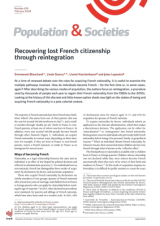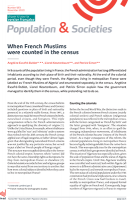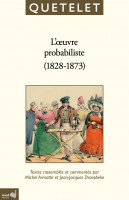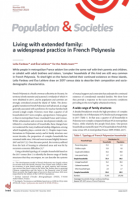
Recovering lost French citizenship through reintegration
Population and Societies
n° 619, February 2024
https://doi.org/10.3917/popsoc.619.0001
Université de Versailles – Saint-Quentin-en-Yvelines (CESDIP), INED, Institut Convergences Migrations (ICM)
INED, Laboratoire de recherche historique Rhône-Alpes (Larhra), Institut Convergences Migrations (ICM)
Lionel Kesztenbaum
INED, Paris School of Economics (PSE)
Université Côte d’Azur, LADIE
Each year, around 100,000 people acquire French nationality, most often based on their family situation (marriage, birth and childhood in France, being parents of French children, etc.). These acquisitions of nationality are also linked to historical and geopolitical transformations. Since the early 1960s, more than 200,000 individuals who lost their French nationality, in many cases when colonized territories became independent, have been reintegrated. The history of reintegration, a discreet and little-known procedure, sheds light on some of the ‘nationality trouble’ of the post-colonial era.
reintegration, nationality, naturalization, citizenship, right of residence, colonial empire, France, acquisition
Table of contents
- Appendix A References
1.
At a time of renewed debate over the rules for acquiring French nationality, it is useful to examine the multiple pathways involved. How do individuals become French – for the first time or, in some cases, again? After describing the various modes of acquisition, the authors focus on reintegration, a procedure used by thousands of people each year to regain their French nationality from the 1980s to the 2010s. Looking at the history of this discreet and little-known option sheds new light on the stakes of losing and acquiring French nationality in a post-colonial context.
The majority of French nationals have been French since birth. Most ‘inherit’ this status from one of their parents (this was the case for around 650,000 newborns in 20221), and a smaller number through ‘double jus soli’ (birth in France to non-French parents, at least one of whom was born in France). In addition, every year around 100,000 people become French through other channels (Figure 1). Individuals can acquire French nationality in various ways, depending on their situation: for example, if they are born in France to non-French parents, marry a French national, or reside in France as an immigrant for several years.
1.1. Ways of becoming French
Nationality, as a legal relationship between the state and an individual, is an effect of law shaped by political decisions and reflected in administrative practices [1]. For individuals born as non-nationals, French law distinguishes three modes of acquisition: by declaration, by decree, and automatic acquisition.
Those who acquire French nationality by declaration are chiefly members of two groups: spouses of French nationals after at least four years of marriage, and children born in France to foreign parents who can apply for citizenship before reaching the age of majority.2 In 2015, other declarative procedures were instituted, for parents and siblings of French nationals, which have since been used on a modest scale. In 2021, 62% of declarations were for minors aged 13–17, and 33% for acquisition for spouses of French nationals.
To acquire nationality by decree, individuals submit an application to the relevant administration, which then makes a discretionary decision. The application can be either for ‘naturalization’3 or ‘reintegration’ into French nationality. Reintegration concerns individuals who previously held French nationality before losing it for personal, family or geopolitical reasons.4 When an individual obtains French nationality, by whatever means, their unmarried minor children also become French through what is known as the ‘collective effect’.
The third pathway to nationality is available only to children born in France to foreign parents. Children whose citizenship was not declared while they were minors become French automatically when they turn 18 by virtue of their birth and residence in France.5 As this mode of acquisition requires no formalities, it is difficult for public statistics to count the exact number of cases, but it is estimated to be several thousand per year (these numbers are not included in Figure 1).
As Figure 1 shows, both the number of individuals acquiring French nationality and their distribution across the different modes of acquisition has varied since the 1960s. These variations are due to changes both in policies and in the number of applicants [2]. For example, in 1973, foreign men married to a French woman gained the right to apply for nationality by declaration (previously only foreign women married to a French man could do so). This led to a progressive increase in the acquisition of nationality by marriage, particularly among Spanish and Portuguese men [3]. From 1985, growth in the acquisition of nationality by declaration was mainly driven by minors: the number of children born to immigrant parents in France was increasing and, until legislative changes in 1993, the parents could apply immediately for the newborn to become French. After a period of stability in the 1970s, naturalizations increased considerably from the late 1980s to the early 2000s, due mainly to a rise in applications from individuals who had been living in France for many years. Some annual variations in the number of acquisitions by decree reflect the accumulation and clearance of administrative backlogs. More broadly, since the 2010s, naturalization procedures have become stricter, with an increase in the number of refusals, so the number of naturalizations has fallen with respect to the previous period. The COVID-19 pandemic accentuated this trend while also creating a backlog of applications. In 2021, its clearance led to a temporary rise in naturalizations for that year.
The data also highlight the increasing scale of reintegration from the 1970s (4–7% of all acquisitions of nationality from 1980 to 2010). Studying this little-known procedure provides insights into the legal, political and social reconfigurations of French nationality under the effect of decolonization (1954-1977), at a time when tens of millions of people ceased to be French.
1.2. Reintegration: the sources of a little-known procedure
The modern legal framework of reintegration began with the Civil Code in 1804. At the time, the aim was to enable individuals who had lost their French nationality for geopolitical reasons to recover their citizenship, in a period when the borders of the Napoleonic Empire were particularly unstable. At the end of the Second Empire, tens of thousands of Alsatians and Mosellans who had been brought under German sovereignty and had become German nationals in 1871, before migrating to other areas that remained within France, made use of this procedure. Moreover, from its origins in 1804, it was also used by women who wished to recover their French nationality after losing it by marrying a foreigner. The term ‘reintegration’ itself appeared for the first time in the law of 26 June 1889 on French nationality. Its meaning and modalities have changed little since then. In its current version, article 24 of the Civil Code specifies that reintegration by decree ‘can be obtained at any age and without minimum duration of residence in France’. Otherwise, it follows the same rules as the procedure for naturalization.
Between 1889 and the 1960s, around 120,000 women who had lost their French nationality after marriage regained their citizenship by decree. This most often happened in association with their husband’s application for naturalization, or following divorce, separation, or widowhood. The automatic loss of nationality upon marriage with a foreigner was abrogated in 1927 (with certain exceptions) and the number of women who were reintegrated decreased steadily up until the 1960s. They were nonetheless still the largest group of individuals reintegrated by decree until 1967, when most became eligible for a new, simplified procedure by declaration (Figure 2). Around the same time, reintegration by decree entered a new phase linked to decolonization.
1.3. Reintegration in the post-colonial period
The French colonial empire was marked by a diversity of statuses and legal pluralism, including with respect to nationality. But with few exceptions, when countries under French imperial rule became independent, individuals who had been classified as ‘indigènes’ (natives) were almost all French nationals.6 These transitions to independence thus led to mass changes in nationality that were neither instantaneous nor always definitive, and of which affected individuals were often unaware [5]. Numerous texts (bilateral conventions, executive orders, laws, etc.) sought to organize transition periods, settle particular cases, and limit opportunities to retain or obtain French nationality by making citizenship provisional or conditional. The law of 28 July 1960, for example, allowed individuals from the former ‘overseas territories’ (TOM) residing in the French Republic (and thus chiefly in mainland France) to have their French nationality ‘recognized’ by declaration.7 This ‘recognition’ of French nationality, rather than its acquisition, represented a sort of ‘right to choose’ (droit d’option). It was abolished in 1973.
In Algeria, the option to choose French nationality was established at the time of independence (1962): persons whose ‘personal status’ made them subject to local law (known until 1958 as ‘French Muslims of Algeria’ (Français musulmans d’Algérie) could apply for a ‘recognitive declaration’ of nationality, on condition of residence in metropolitan France. Around 60,000 individuals (excluding minors whose nationality was established by ‘collective effect’) retained their French nationality in this way following Algeria’s independence. As of 21 March 1967, former ‘French Muslims of Algeria’ who had not submitted an application were deemed to have lost their French nationality on 1 January 1963. Beginning in 1967, however, Algerians born before independence who had emigrated to metropolitan France were able to apply for ‘reintegration’ by decree (having been French until 1962, they could not be ‘naturalized’), resulting in a steady rise in this mode of acquisition of French nationality over the following years and decades.
1.4. A gradual downtrend after a peak in 2005
The annual number of reintegrations topped 1,000 in 1975 and increased steadily over the subsequent years (Figure 2). The largest groups of reintegrated individuals were of Vietnamese and Algerian origin. From the mid-1990s, they were joined by individuals from the former TOMs, who until that point had been eligible for other procedures. This explains the increase in the proportion of ‘other nationalities’ following the legislative reform of 1993, although they remained a small minority (Figure 3). Annual reintegrations continued to grow to a peak of more than 10,000 in 2005, including nearly 9,000 Algerians. Paradoxically, this also marked the end of a brief and limited golden age of reintegration.
Over the period 1990–2010, in the broader context of a general expansion in acquisitions of French nationality, the rise in reintegrations was linked to the massive increase in the number of applications by Algerians (Figures 2 and 3) at the height of the country’s ‘Dark Decade’ (civil war in the 1990s). The initial results of the NATIO2 survey suggest that reintegration enabled Algerians not entitled to official refugee status under the 1951 Geneva Convention to settle in France. In the subsequent decade, the population eligible for reintegration progressively dwindled, due notably to the decrease in the number of persons born in France’s former colonies before independence with the status of ‘colonisé’.8 The annual number of reintegrations has fallen ten-fold since the early 2000s. In 2020, fewer than 800 persons recovered their French nationality in this way, whether or not they were born in the former colonial empire. The post-colonial period of ‘reintegration’ into French nationality is coming to an end, but political controversies around nationality and changes in nationality law continue to bear the marks of colonial history [6].
Appendix A References
-
[1] Lepoutre J. 2020. Nationalité et souveraineté. Dalloz, ‘Nouvelle Bibliothèque de Thèses’.
-
[2] Weil P. 2005 (2002). Qu’est-ce qu’un Français ? Histoire de la nationalité française depuis la Révolution française. Gallimard.
-
[3] Spire A., Thave S. 1999. Les acquisitions de nationalité française depuis 1945. Insee Synthèses, 30, 35–54.
-
[4] Masure F. 2014. Qu’est-ce que devenir Français ? Approche anthropologique de la nationalité. Presses universitaires du Mirail.
-
[5] Benfoughal T. 2016. Brahim Benfoughal, né ‘sujet français’. Ethnologie française, 46, 459-470.
-
[6] Calvo S., Drevet J., Johnstone E. 2021. Combien pèse l’histoire coloniale dans le droit de la nationalité ? Délibérée, 14, 28–36.
Representing 88% of births in France in 2022. https://www.insee.fr/fr/statistiques/2381382#tableau-figure1_radio1
For children aged 13–15, their legal representatives can apply for French nationality on their behalf subject to proof of the child’s residence in France for five years since the age of 8. From age 16, minors can apply directly.
There have been various sociological studies on this well-known procedure. In particular, see [4].
The uses of this little-known procedure are the focus of the NATIO2 research project (Reintegration into French nationality by decree, 1960-2020), based at INED and funded by the Institut Convergences Migrations (CNRS, ANR-17-CONV-0001).
Since 2018, in Mayotte, in addition to the conditions of birth in France and length of residence, a clause requiring one parent to have been legally resident for more than 3 months at the time of birth has been added.
In the French colonial empire, the term ‘indigène’ referred to a subordinate legal status along with a specific system of administrative and penal control that applied to most of the populations of the colonized territories. This status, abolished in 1946, did not exist in the ‘protectorates’ (such as Morocco and Tunisia), whose indigenous inhabitants were not ‘French subjects’.
This text applied to the areas classified as TOMs on 31 December 1946, namely: Côte d’Ivoire, Dahomey, Guinea, Mauritania, Niger, Senegal, French Sudan (Mali), Upper Volta (Burkina Faso), French Congo, Gabon, Ubangi-Shari (Central African Republic), Chad, Comoros, territories in India (mainly Pondicherry), Madagascar, New Caledonia, territories in Oceania (French Polynesia, Wallis and Futuna, etc.), Saint Pierre and Miquelon, and French Somaliland.
Even individuals born in metropolitan France can be eligible for reintegration: for example, persons born in France before 1963 to parents who then became Algerian.
Each year, around 100,000 people acquire French nationality, most often based on their family situation (marriage, birth and childhood in France, being parents of French children, etc.). These acquisitions of nationality are also linked to historical and geopolitical transformations. Since the early 1960s, more than 200,000 individuals who lost their French nationality, in many cases when colonized territories became independent, have been reintegrated. The history of reintegration, a discreet and little-known procedure, sheds light on some of the ‘nationality trouble’ of the post-colonial era.
Emmanuel Blanchard - Université de Versailles – Saint-Quentin-en-Yvelines (CESDIP), INED, Institut Convergences Migrations (ICM)
Linda Guerry - INED, Laboratoire de recherche historique Rhône-Alpes (Larhra), Institut Convergences Migrations (ICM)
Lionel Kesztenbaum - INED, Paris School of Economics (PSE)
Jules Lepoutre - Université Côte d’Azur, LADIE
Cite the article
Emmanuel Blanchard, Linda Guerry, Lionel Kesztenbaum and Jules Lepoutre, Recovering lost French citizenship through reintegration, 2024, Population and Societies, no. 619
 This document may be reproduced free of charge on paper or online using our Creative Commons licence.
This document may be reproduced free of charge on paper or online using our Creative Commons licence.











